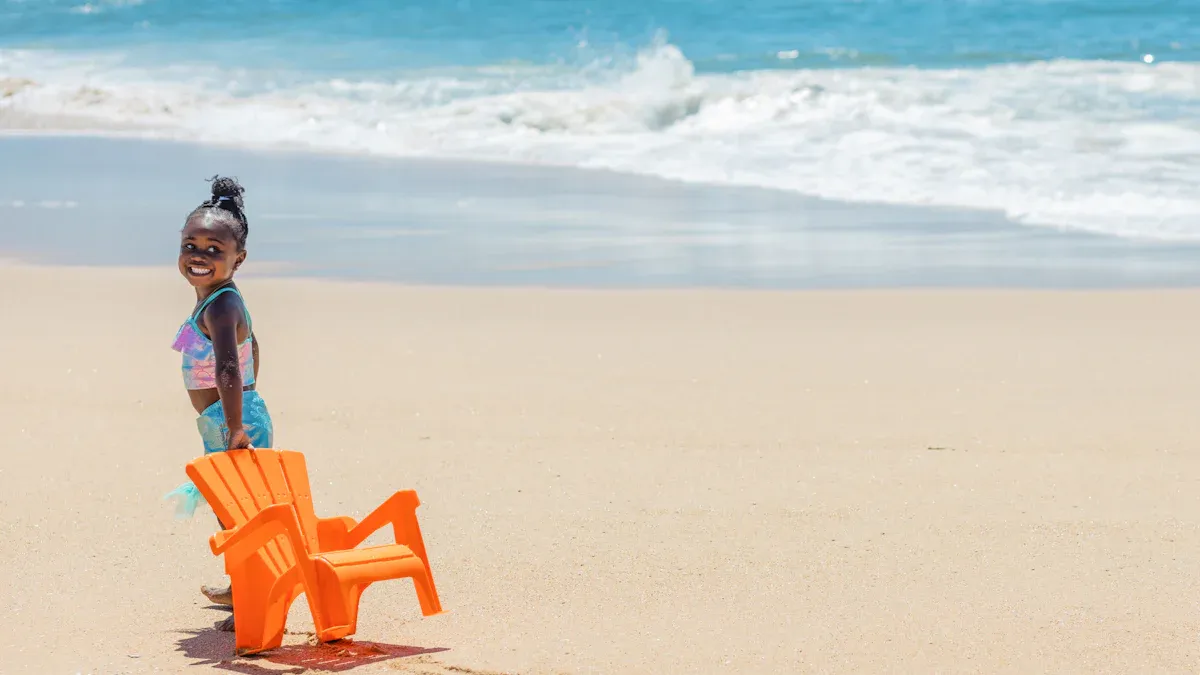
Starting a swimwear line is more than just creating stylish beachwear—it's a chance to bring your creativity to life and make waves in a thriving industry. The global swimwear market, valued at $21.22 billion in 2024, is set to grow to $30.59 billion by 2032, with a steady annual growth rate of 4.79%. This booming market offers endless opportunities for you to carve out your niche as you start a swimwear line. Whether you're dreaming of bold designs or sustainable collections, the possibilities are endless. So, why not dive in and turn your vision into reality?
Key Takeaways
Decide your goals and ideas before starting your swimwear brand. Knowing why you want to do this will help you stay focused.
Study the market to find trends and missing products. Learning what people like helps you make designs they will love.
Create a strong business plan with money details and marketing ideas. This plan will keep you organized and on track.
Pick eco-friendly materials for your swimwear. Green choices attract buyers who care about the planet and help the environment.
Ask customers for feedback after you start selling. Use their thoughts to make better products and keep them coming back.
Define Your Vision and Goals
Starting a swimwear line begins with a clear vision. Knowing your "why" and defining your brand identity will set the foundation for your success. Let’s break it down step by step.
Identify Your Motivation
Why you want to start a swimwear line
Ask yourself: What’s driving you to start a swimwear line? Maybe you’ve always been passionate about fashion, or you’ve noticed a gap in the market for inclusive swimwear. Your motivation will guide your decisions and keep you focused when challenges arise. Write it down and revisit it often—it’s your anchor.
Long-term goals for your brand
Think about where you want your brand to be in five or ten years. Do you dream of seeing your designs on runways or creating a sustainable swimwear empire? Setting long-term goals helps you stay on track and measure your progress. Be specific. For example, you might aim to launch five collections in three years or expand into international markets.
Establish Your Brand Identity
Define brand values and mission
Your brand values and mission are the heart of your swimwear line. What do you stand for? Maybe it’s sustainability, body positivity, or luxury. These values should align with your mission statement, which explains what your brand aims to achieve. For example, if sustainability is your focus, your mission might be to create eco-friendly swimwear that doesn’t compromise on style.
Decide on your target audience and style
Who are you designing for? Defining your target audience is crucial. Are they young professionals looking for trendy designs, or families seeking practical swimwear? Once you know your audience, tailor your style to their preferences. Use visual elements like patterns, colors, and fonts that resonate with them. Consistency across your designs and messaging will help build trust and recognition.
Pro Tip: A strong brand identity includes a memorable name, a recognizable logo, and a cohesive story. These elements should reflect your values and connect emotionally with your audience.
Conduct Market Research and Find Your Niche
Analyze the Swimwear Market
Study trends and consumer preferences
Understanding the swimwear market is essential before you start a swimwear line. Trends in this industry evolve quickly, and staying informed will help you create designs that resonate with your audience. Here are some current trends shaping the market:
Advanced materials like high-performance Lycra and spandex blends are improving stretchability, durability, and UV protection.
Compression technology is gaining popularity among competitive swimmers for its hydrodynamic benefits and muscle support.
E-commerce platforms have revolutionized how people shop for swimwear, offering convenience and a wider variety of options.
Sustainability is a growing focus, with many brands using recycled materials to attract eco-conscious consumers.
By studying these trends, you can identify what appeals to your target audience and incorporate those elements into your designs.
Identify market gaps
Finding a gap in the market is your chance to stand out. For example, some brands have successfully addressed the lack of stylish swimwear for larger sizes by offering supportive yet fashionable options. Others have introduced artisanal swimwear, like handmade bikini sets or unique designs such as G-strings, to cater to niche audiences. Sustainability also presents opportunities, with brands like MeUndies creating swimwear from recycled ocean netting and bottles. Look for areas where consumer needs aren’t being met and position your brand to fill those gaps.
Tip: Pay attention to customer reviews of existing brands. They often highlight unmet needs or frustrations that you can address.
Define Your Unique Selling Proposition
What makes your swimwear line stand out
Your unique selling proposition (USP) is what sets your brand apart. It could be anything from using eco-friendly materials to offering inclusive sizing or innovative designs. For instance, some brands focus on comfort and support by using high-quality stretchy fabrics, while others emphasize sustainability with fair trade manufacturing processes. Think about what makes your swimwear special and how it aligns with your brand values.
Addressing customer needs better than competitors
To succeed, you need to solve problems better than anyone else. If your target audience struggles to find swimwear that fits well, offer a range of sizes with designs that prioritize comfort and style. If sustainability is important to your customers, use recycled fabrics and highlight your eco-friendly practices. By addressing these needs, you’ll build trust and loyalty with your audience.
Pro Tip: Clearly communicate your USP in your marketing materials. Whether it’s through your website, social media, or packaging, make sure your audience knows what makes your brand unique.
Develop a Business Plan
Creating a solid business plan is essential when you start a swimwear line. It helps you map out your finances, build a strong brand, and strategize your marketing efforts. Let’s break it down step by step.
Create a Financial Plan
Estimate startup costs
Before diving in, you need to know how much money you’ll need to get started. The costs can vary depending on the scale of your business:
Small startups typically require $5,000 to $10,000.
Medium-sized businesses may need $15,000 to $30,000.
Larger brands could require up to $50,000.
If you’re planning to open a swimwear boutique, the costs could range from $40,000 to $250,000, depending on factors like location and size. Start by listing all potential expenses, such as design, manufacturing, marketing, and website development. This will give you a clear picture of your financial needs.
Plan pricing and profit margins
Pricing your swimwear is a balancing act. You want to cover your costs while staying competitive. Research your competitors’ pricing and consider your target audience’s budget. For example, if you’re targeting eco-conscious buyers, they may be willing to pay a premium for sustainable materials. Aim for a profit margin of at least 30% to ensure your business remains profitable.
Build Your Brand
Choose a brand name and logo
Your brand name and logo are the first things customers notice. Choose a name that reflects your values and resonates with your audience. Keep it simple, memorable, and unique. Pair it with a logo that visually represents your brand’s personality. For instance, if your focus is on sustainability, use earthy tones and natural elements in your design.
Develop a cohesive brand story
A compelling brand story can set you apart. Share the inspiration behind your swimwear line and the values that drive your business. Maybe your passion for fashion or a love for the ocean sparked your journey. Authenticity is key—it helps build trust and loyalty. Use your story to create engaging content that connects with your audience and makes them feel part of your brand’s journey.
Plan Your Marketing Strategy
Social media and digital marketing approach
Social media is your best friend when marketing swimwear. Platforms like Instagram and Pinterest are perfect for showcasing your designs because of their visual nature. Did you know that top swimwear brands on Instagram have an engagement rate of 0.88%, far above the industry average? Use high-quality photos, collaborate with influencers, and share your brand story to captivate your audience.
Decide on sales channels
Choosing the right sales channels is crucial. Many successful swimwear brands thrive on e-commerce platforms. Create a user-friendly website or sell through online marketplaces like Amazon. Brands like Cupshe have combined direct-to-consumer sales with Amazon, achieving impressive growth. Retail partnerships can also boost visibility. Collaborating with stores like Forever 21 or ASOS can help you reach a wider audience.
Pro Tip: Diversify your sales channels to maximize your reach. A mix of online and retail options can help you grow faster.
Design and Manufacture Your Swimwear

Designing and manufacturing your swimwear is where your vision truly comes to life. From choosing materials to ensuring inclusivity, every step matters in creating a product your customers will love.
Focus on Design
Choose sustainable materials
Sustainability is more than a trend—it's a responsibility. Choosing eco-friendly materials not only helps the planet but also appeals to conscious consumers. Here’s why sustainable materials are a win-win:
They reduce environmental impact by lowering carbon footprints.
Modern options like recycled polyester and Econyl are durable and perform well against chlorine and saltwater.
Eco-friendly fabrics are designed for comfort and longevity, reducing waste over time.
Popular choices include recycled polyester (made from plastic bottles), Econyl (recycled nylon), and Repreve (fabric from PET bottles). Brands like Sienna and Ezz Studios have proven that these materials can deliver high-quality swimwear without compromising on style or performance.
Create designs for your target audience
Your designs should reflect your audience’s preferences. Are they looking for bold patterns or minimalist styles? Think about functionality too. For example, active swimmers may prefer streamlined designs, while vacationers might lean toward trendy, eye-catching pieces. Sketch your ideas, experiment with colors, and always keep your brand identity in mind.
Tip: Test your designs with a small focus group to gather feedback before finalizing them.
Find the Right Manufacturer
Research and vet manufacturers
Finding the right manufacturer is crucial for bringing your designs to life. Look for manufacturers who:
Have strict quality assurance protocols, like fabric inspections and seam strength testing.
Can handle custom designs and adapt to changes efficiently.
Offer scalability to meet growing demand and provide clear production timelines.
Communicate effectively and provide transparent cost breakdowns.
A reliable manufacturer ensures your swimwear meets high standards and aligns with your brand’s values.
Ensure quality control and ethical practices
Quality control is non-negotiable. Manufacturers should test for colorfastness, seam strength, and elasticity to ensure your swimwear holds up under real-world conditions. Ethical practices are equally important. Choose partners who source materials responsibly and maintain transparency in their processes. This not only builds trust with your customers but also strengthens your brand’s reputation.
Address Sizing and Inclusivity
Offer a range of sizes
Inclusivity is key to reaching a broader audience. Offering a wide range of sizes ensures everyone feels represented. Consider creating designs that flatter different body types while maintaining comfort and style. This approach can set your brand apart in a competitive market.
Test fit and comfort
Fit sessions are essential during the prototyping phase. Have models try on your samples and provide feedback on comfort, fit, and aesthetics. This iterative process helps you refine your designs and address issues like tightness or discomfort. Multiple rounds of testing ensure your swimwear meets both your standards and your customers’ expectations.
Pro Tip: Prioritize comfort without sacrificing style. A well-fitting swimsuit can turn first-time buyers into loyal customers.
Market, Launch, and Grow Your Brand

Build Buzz Before Launch
Use social media to tease designs
Social media is your playground for building excitement before your launch. Platforms like Instagram and TikTok let you showcase your designs while engaging with your audience. Use Instagram Stories polls to ask your followers about their favorite colors or styles. Send teaser emails to your subscribers, giving them a sneak peek of your collection. These small actions make your audience feel involved in the process.
Successful swimwear brands often use storytelling to create anticipation. Share behind-the-scenes clips of your design process or post short videos of your prototypes. This approach not only builds curiosity but also makes your audience feel like they’re part of your journey.
Tip: Ask questions like, “Which design should we launch first?” to encourage interaction and build a sense of community.
Collaborate with influencers
Influencers can amplify your brand’s reach and help you connect with a broader audience. Partner with influencers who align with your swimwear’s style and values. For example, if your focus is on sustainability, work with eco-conscious influencers who can authentically promote your products.
Influencers can drive traffic to your website and boost sales.
They create content that showcases your swimwear in real-life settings, making it relatable.
Track the results of these collaborations to see what works best for your brand.
By teaming up with the right influencers, you’ll create buzz and attract potential customers who trust their recommendations.
Launch Your Swimwear Line
Host a launch event or campaign
A creative launch event can set the tone for your brand. Consider hosting a photoshoot and sharing behind-the-scenes clips on social media. Go live on Instagram or TikTok for a try-on session, where you showcase your designs and answer questions in real time.
For a more exclusive approach, take inspiration from Calzedonia, which hosted a glamorous event featuring models, influencers, and curated experiences. This type of event not only grabs attention but also creates a memorable impression of your brand.
Offer promotions to attract customers
Promotions are a great way to draw in your first customers. Use email marketing to send discount codes or offer free shipping during your launch week. Highlight customer reviews and testimonials to build trust.
Engage your audience with style guides that show how versatile your swimwear can be. For example, demonstrate how one piece can transition from the beach to a casual outing. These strategies add value and encourage purchases.
Gather Feedback and Iterate
Collect customer reviews
Customer feedback is gold when you’re starting out. Use surveys or feedback forms to ask specific questions about fit, comfort, and design. Make it easy for customers to share their opinions by including links to review platforms in your emails or on your website.
Pro Tip: Respond to reviews, both positive and negative. It shows you care about your customers’ experiences.
Use insights to improve products
Take action based on the feedback you receive. If customers mention sizing issues, adjust your patterns. If they love a particular design, consider expanding it into different colors or styles. Brands like Summersalt and Cupshe have successfully used customer insights to refine their collections and cater to specific needs, such as postpartum comfort or intricate design details.
By listening to your customers, you’ll not only improve your products but also build loyalty and trust.
Starting a swimwear line might seem overwhelming, but breaking it into clear steps makes it manageable. Here’s a quick recap to guide you:
Operational Plan: Map out daily tasks like manufacturing and distribution.
Financial Projections: Estimate costs and potential profits to stay on track.
Budgeting: Account for materials, marketing, and operational expenses.
Legal Considerations: Choose a business structure and ensure ethical practices.
Production Process: Partner with reliable manufacturers and maintain quality control.
Success stories like Melanie Travis, who founded Andie, show what’s possible. She turned her vision into a thriving brand by understanding customer needs and raising millions in funding. Her journey proves that with determination and a solid plan, you can achieve your goals too.
So, take that first step today. Your swimwear line could be the next big thing!
FAQ
What’s the best way to start designing my swimwear?
Start by sketching your ideas. Think about your target audience and their preferences. Use mood boards for inspiration and experiment with colors, patterns, and styles. Keep your brand identity in mind while creating designs that stand out.
Tip: Test your designs with a small focus group to get valuable feedback!
How do I choose the right manufacturer for my swimwear line?
Research manufacturers who specialize in swimwear. Look for those with experience in quality control, ethical practices, and scalability. Request samples to evaluate their work before committing. Communication is key—choose someone who understands your vision.
Pro Tip: Ask for references or reviews from other brands they’ve worked with.
How much money do I need to start a swimwear line?
Startup costs vary. Small businesses might need $5,000–$10,000, while larger brands could require $50,000 or more. Create a detailed budget that includes design, manufacturing, marketing, and website expenses.
Note: Don’t forget to account for unexpected costs like shipping or sample revisions.
How can I market my swimwear line effectively?
Use social media platforms like Instagram and TikTok to showcase your designs. Collaborate with influencers to expand your reach. Build an email list and send updates about your launch, promotions, or new collections.
Emoji Tip: High-quality photos and videos can make your swimwear shine online!
Should I offer inclusive sizing in my swimwear line?
Absolutely! Offering a range of sizes helps you reach a broader audience and shows that your brand values inclusivity. Focus on designs that flatter different body types while maintaining comfort and style.
Reminder: Inclusivity isn’t just a trend—it’s a way to build trust and loyalty.
